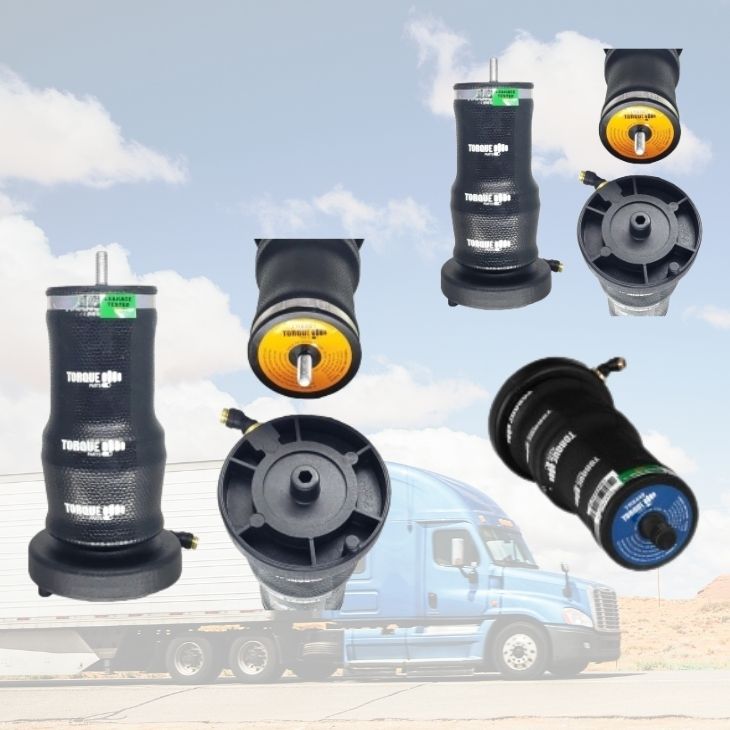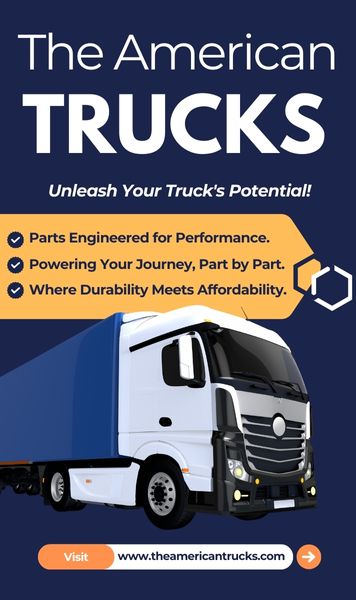
Table of Contents
ToggleCabin Air Springs A Key Component for Smooth and Comfortable Trucking
Introduction
For drivers of American trucks, comfort is as important as performance. Cabin air springs provide a vital solution, enhancing the ride quality and stability of the truck cabin. At TORQUE PARTS, we understand the importance of durable, high-quality components like cabin air springs, which not only elevate comfort but also reduce wear on the vehicle over time. In this article, we’ll explore what cabin air springs are, their benefits, types, maintenance tips, and why they’re essential for heavy-duty trucking.
What Are Cabin Air Springs?
Cabin air springs, or cab air suspension systems, are components designed to absorb shock and reduce vibration in truck cabins. Unlike traditional steel springs, air springs utilize pressurized air, offering a more adaptive and flexible response to road conditions. Positioned between the cabin and chassis, they help create a buffer that stabilizes the cabin, protecting the driver from harsh impacts and ensuring a smooth ride.
Key Benefits of Cabin Air Springs
- Enhanced Comfort
Cabin air springs reduce the impact of bumps and road irregularities, providing a more comfortable experience. This is particularly valuable for long-haul drivers who spend extended hours behind the wheel. - Reduced Vibration
By minimizing vibrations, these air springs protect cabin equipment and electronic devices, reducing the likelihood of damage. - Driver Fatigue Reduction
Smooth rides prevent driver fatigue, improving focus and reducing the risk of accidents caused by discomfort or drowsiness. - Longevity for Cabin Components
The cushioning effect protects internal parts from wear, which can extend the lifespan of cabin features and reduce maintenance costs.
Types of Cabin Air Springs
Understanding the different types of cabin air springs can help in selecting the right product for specific trucking needs.
- Rolling Lobe Air Springs
Known for flexibility and range, these are popular for their ability to handle varying load capacities without compromising ride quality. - Convoluted Air Springs
Typically designed for high-load applications, these springs feature layers for added durability and stability, ideal for heavy-duty trucks. - Sleeve Air Springs
Compact and versatile, sleeve air springs are suitable for limited space in truck cabins, providing effective cushioning while saving space.
How Cabin Air Springs Work
Cabin air springs operate by utilizing compressed air, which fills the spring unit. When a truck encounters uneven road surfaces, the air within the spring compresses and absorbs the impact. This mechanism creates a buffer, which limits the transfer of vibration and shock to the driver. The result is a smooth, even ride that greatly enhances the driving experience.
Importance of Quality Cabin Air Springs in Heavy-Duty Trucks
In heavy-duty trucking, where trucks haul heavy loads over long distances, the quality of cabin air springs becomes critical. High-grade air springs ensure that the cabin remains stable, even in challenging conditions, offering essential protection to both the driver and the vehicle. Investing in quality air springs is crucial for fleet owners and independent drivers alike to minimize downtime and maximize efficiency.
Signs of Worn or Failing Cabin Air Springs
Regular inspection of cabin air springs is essential to maintain a high-performance trucking experience. Here are some signs indicating that it may be time to replace your cabin air springs:
- Increased Cabin Vibration
If you notice unusual vibrations or bumps, your air springs may not be absorbing impact as effectively. - Uneven Cabin Height
A sinking or uneven cabin position can indicate deflated or damaged air springs. - Air Leaks
Hearing air escaping or a hiss around the springs suggests a potential air leak, which can cause reduced effectiveness.
Maintenance Tips for Cabin Air Springs
Proper maintenance can extend the life of cabin air springs and ensure consistent performance. Consider these practical tips:
- Regular Inspections
Examine air springs for any visible signs of wear, cracks, or deflation. Identifying issues early can prevent bigger problems down the road. - Check for Leaks
Routinely test for air leaks by applying soapy water around the connections. Bubbles indicate leaks that need addressing. - Keep Connections Tight
Ensure that all bolts and connections are secure. Loose parts can cause unnecessary wear and tear on the air springs. - Monitor Cabin Position
An uneven or tilted cabin may indicate that an air spring needs replacement. Regular monitoring can help identify these issues early. - Replace as Needed
If you notice recurring issues, it may be more cost-effective to replace the air springs rather than constantly repairing them.
How to Choose the Right Cabin Air Springs
Selecting the right cabin air springs is essential to match the needs of your truck and driving conditions.
- Consider Load Capacity
Trucks carrying heavier loads may require more robust air springs, such as convoluted designs. - Check Compatibility
Ensure that the air springs are compatible with your truck model and fit your cabin’s requirements. - Assess Ride Quality Needs
For drivers who prioritize comfort, rolling lobe air springs can offer a smoother experience. - Quality and Durability
Choose air springs from reputable manufacturers that use high-quality materials to ensure longevity and reliability. - Professional Installation
A proper installation is key for optimal performance. Consider hiring a professional or following manufacturer guidelines if you plan to install the springs yourself.
Why TORQUE PARTS’ Cabin Air Springs?
At TORQUE PARTS, we provide durable, reliable cabin air springs specifically engineered for American trucks. Our products are designed to withstand the demanding conditions of heavy-duty trucking, ensuring maximum comfort, safety, and longevity for our customers. Each air spring undergoes rigorous quality testing to meet high performance and durability standards, giving you the peace of mind to focus on the journey ahead.
Frequently Asked Questions (FAQ) on Cabin Air Springs
Q: How long do cabin air springs typically last?
A: With regular maintenance, cabin air springs can last between 80,000 and 100,000 miles, though this can vary depending on driving conditions and load.
Q: Can I replace cabin air springs myself?
A: It’s possible to replace them yourself if you have the necessary tools and follow the manufacturer’s instructions. However, professional installation is recommended to ensure a proper fit and optimal performance.
Q: What’s the difference between cabin air springs and suspension air springs?
A: Cabin air springs are designed to absorb shock within the cabin area, while suspension air springs are installed in the main suspension system, primarily for load-bearing and vehicle height adjustment.
Q: Do cabin air springs affect fuel efficiency?
A: Yes, by enhancing stability and reducing the impact of road vibrations, air springs can contribute to improved fuel efficiency over time.
Final Thoughts
Cabin air springs play a pivotal role in the trucking industry by improving ride quality, reducing wear, and ensuring a stable and comfortable driving experience. At TORQUE PARTS, we are committed to providing high-quality cabin air springs tailored for American trucks. With the right air springs and regular maintenance, you can enhance your truck’s performance, protect your investment, and enjoy a smoother ride on every journey.
Follow us to get detailed information: Cabin Air Springs
Check out our articles Air Springs




